Minaurum Drills 9.90 m Grading 609 g/t Silver at Alamos Silver Project
Minaurum Gold, Inc (“Minaurum”) (TSXV:MGG) (OTCQX:MMRGF) is pleased to announce it has returned high-grade silver intercepts from the final Phase II holes drilled in 2021 at its flagship Alamos silver project in Sonora, Mexico. In 2021, Minaurum drilled 9,386.50 m in 22 holes focusing on sizable step-outs at the Ana, Europa, San José, Alessandra, Cotera, and Minas Nuevas vein zones. The best results obtained in the Minas Nuevas, Cotera and San Jose vein zones are as follows.
Highlights include:
Minas Nuevas vein zone
- Hole AL21-099 returned 9.90 m @ 609 g/t Ag; including 0.90 m @ 1,145 g/t Ag, 0.50 m @ 2,260 g/t Ag, and 0.50 m @ 2,360 g/t Ag
Cotera vein zone
- Hole AL21-094 returned 1.05 m @ 411 g/t Ag and 2.66% Zn; and 0.95 m @ 763 g/t Ag and 2.14% Cu; and 0.30 m @ 2,310 g/t Ag and 6.52% Cu
San José vein zone
- Hole AL21-091 returned 21.70 m @ 93 g/t Ag; including 4.85 m @ 159 g/t Ag
- Hole AL21-092A returned 7.35 m @ 184 g/t Ag; including 4.05 m @ 289 g/t Ag
“Our Phase II drill program of aggressive step-outs has yielded high-grade silver results at the Cotera, Minas Nuevas and San José veins, significantly expanding the known mineralized footprint of each target” stated Darrell Rader, Minaurum President and CEO. “We are now planning to transition to more closely-spaced drilling as we advance the Alamos project. We will be providing an update shortly on our plans for 2022.”
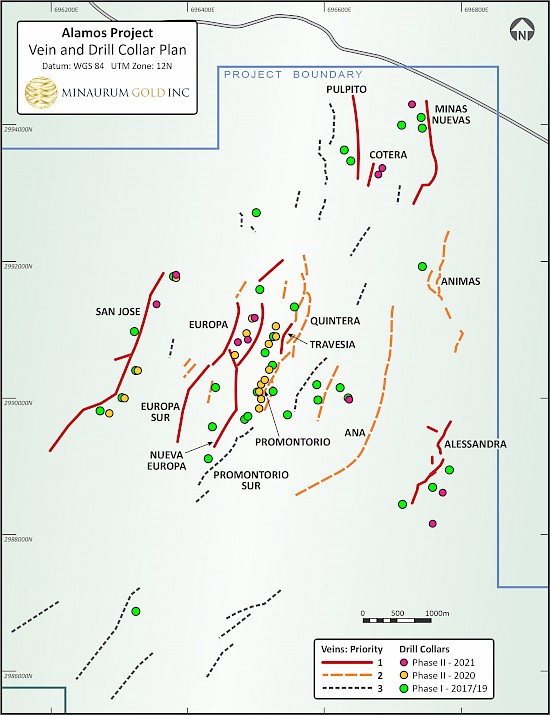
Figure 1. Alamos project vein zones and drill-hole collars. Click on image to enlarge.
Minas Nuevas vein zone
Minas Nuevas consists of a group of veins located in the NE of the Alamos concession block. In its northern-most section, the vein bends sharply to the northwest encompassing the Zambona vein, where historical records and reports indicate that mine workings followed a northwest-plunging silver shoot. Holes AL21-098 and -099 are the first ever holes to test the Zambona vein zone (Figures 2 and 3).
Hole AL21-099 intersected strong silver mineralization of 609 g/t Ag over 9.90 m, including 0.90 m @ 1,145 g/t Ag, 0.50 m @ 2,260 g/t Ag, and 0.50 m @ 2,360 g/t Ag, intersecting the shoot near the NW-most extent of the workings, leaving prospective ground further to the northwest along strike and down-plunge. Hole AL21-098 intersected several metres of quartz-carbonate veining with trace silver mineralization in the hanging wall of the fault contact with granodiorite, and appears to have been drilled underneath the silver shoot. Highlights of Minas Nuevas vein zone drilling are shown in Table 1.
Table 1. Highlights of hole AL21-099, Minas Nuevas vein zone.
| Hole | From (m) | To (m) | Interval (m) | Ag g/t | Au g/t | Cu % | Pb % | Zn % |
|---|---|---|---|---|---|---|---|---|
| AL21-099 | 185.60 | 196.50 | 9.90 | 609 | 0.01 | 0.18 | 0.27 | 0.47 |
| including | ||||||||
| 187.15 | 188.05 | 0.90 | 1145 | 0.05 | 0.12 | 1.23 | 2.48 | |
| and | ||||||||
| 189.10 | 195.50 | 6.40 | 753 | 0.03 | 0.23 | 0.2 | 0.27 | |
| which includes | ||||||||
| 192.20 | 192.70 | 0.50 | 2260 | 0.03 | 0.24 | 0.47 | 0.54 | |
| and | ||||||||
| 195.00 | 195.50 | 0.50 | 2360 | 0.03 | 0.2 | 0.3 | 0.54 | |
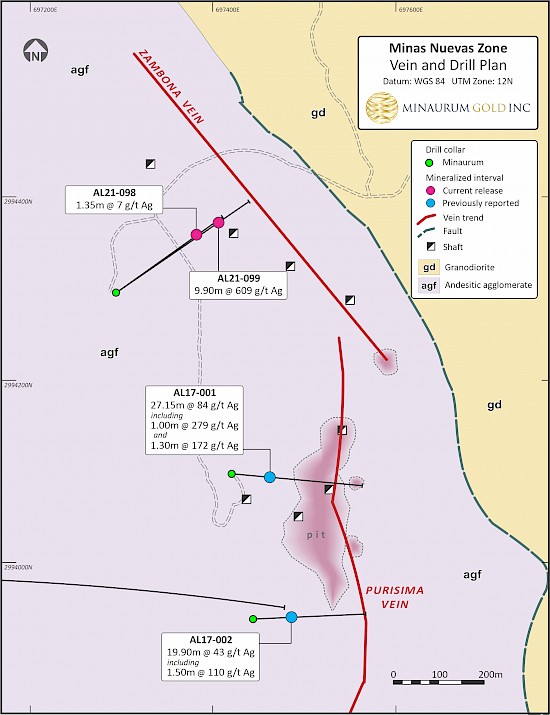
Figure 2. Minas Nuevas zone, showing Minaurum drilling and intercepts. Click on image to enlarge.
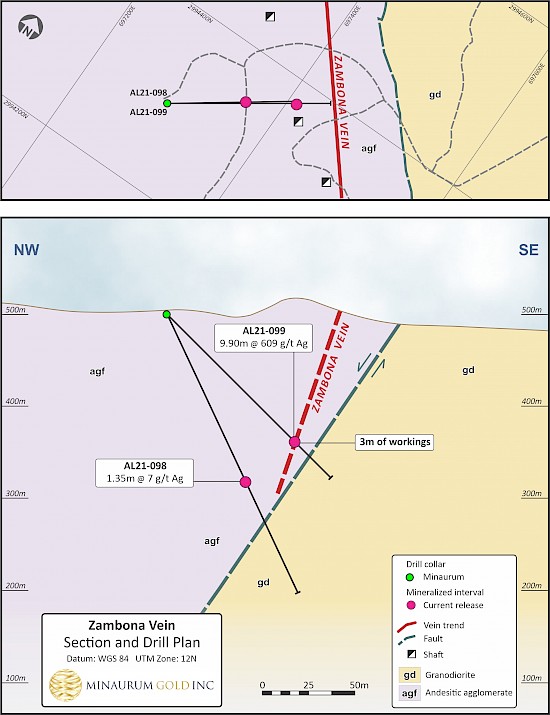
Figure 3. Cross section of holes AL21-098 and AL21-099. Click on image to enlarge.
San José Vein zone
Stepping out to the north from previous drilling, hole AL21-091 intersected a wide zone of 21.90 m @ 93 g/t Ag in the highest part of the hole (Figures 4 and 5). Hole AL21-092A expanded the vein zone 250 m to the southwest of -091 (Figures 4 and 5), intersecting continuous silver mineralization of 7.35 m @ 184 g/t Ag including 1.30 m @ 649 g/t Ag (Figure 5). Mineralization in both intercepts occurs in fractured and veined andesite immediately above the fault contact with granodiorite. Highlights of San José vein zone drilling are shown in Table 2.
Table 2. Highlights of holes AL21-089, -091, -092A, and -092, San José vein zone.
| Hole | From (m) | To (m) | Interval (m) | Ag g/t | Au g/t | Cu% | Pb % | Zn % |
|---|---|---|---|---|---|---|---|---|
| AL21-089 | 98.00 | 108.70 | 10.70 | 50 | 0.004 | 0.03 | 0.06 | 0.14 |
| including | ||||||||
| 99.45 | 101.05 | 1.60 | 124 | 0.02 | 0.09 | 0.19 | 0.48 | |
| AL21-091 | 40.25 | 61.95 | 21.70 | 93 | 0.01 | 0.1 | 0.19 | 0.24 |
| including | ||||||||
| 46.05 | 53.65 | 7.60 | 135 | 0.02 | 0.18 | 0.38 | 0.38 | |
| which includes | ||||||||
| 48.80 | 53.65 | 4.85 | 159 | 0.02 | 0.22 | 0.44 | 0.41 | |
| AL21-092A | 131.50 | 138.85 | 7.35 | 184 | 0.02 | 0.22 | 0.21 | 0.27 |
| including | ||||||||
| 131.90 | 135.95 | 4.05 | 289 | 0.03 | 0.38 | 0.34 | 0.43 | |
| which includes | ||||||||
| 133.65 | 134.70 | 1.05 | 746 | 0.06 | 0.99 | 0.92 | 0.93 | |
| AL21-092 | 130.90 | 136.45 | 5.55 | 148 | 0.02 | 0.15 | 0.2 | 0.49 |
| including | ||||||||
| 130.90 | 134.65 | 3.75 | 196 | 0.02 | 0.17 | 0.15 | 0.35 | |
| which includes | ||||||||
| 132.70 | 133.40 | 0.70 | 321 | 0.03 | 0.23 | 0.13 | 0.79 | |
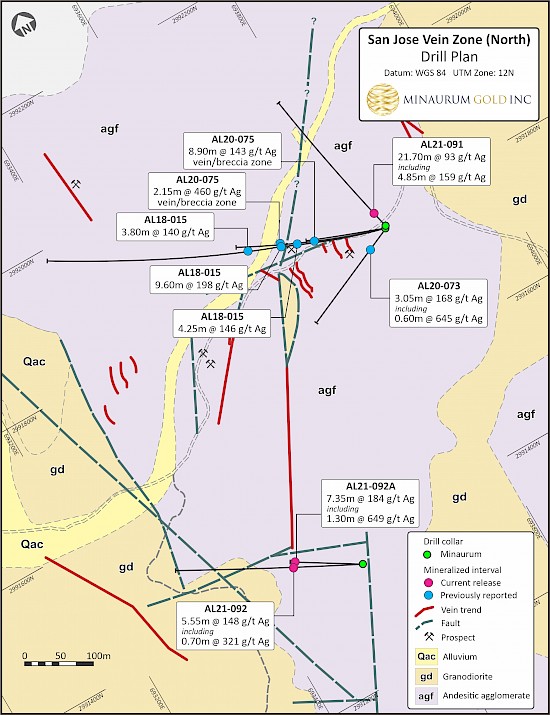
Figure 4. Northern part of San José zone. Click on image to enlarge.
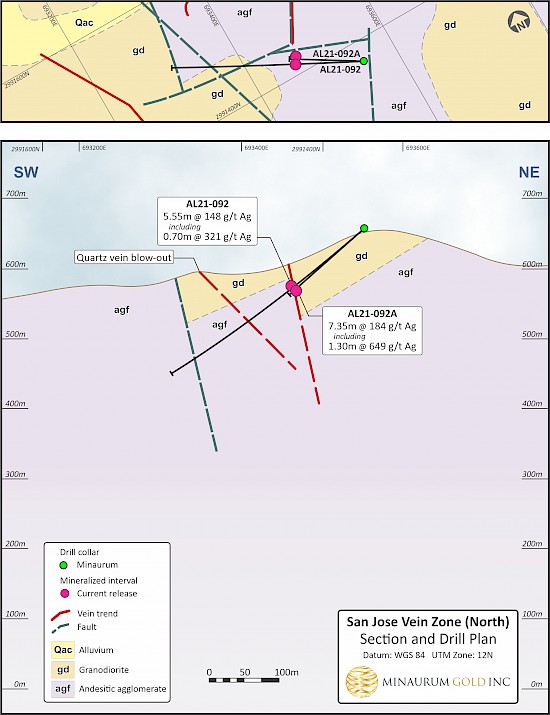
Figure 5. San Jose cross section showing holes AL21-092 and AL21-092A. Click image to enlarge.
Cotera Vein Zone
The north-south-striking, steeply dipping Cotera zone extends for a kilometre to the north and 300 m to the south of the drilled area. Holes AL21-094 and -095 cut the Cotera zone approximately 80 metres south of Hole AL19-035 intercept (Figures 6 and 7). AL21-094 intersected high-grade silver and copper of 0.30 m @ 2,310 g/t Ag and 6.52% Cu within an interval of 2.10 m @ 360 g/t Ag and 1.00% Cu and 2.95 m @ 232 g/t Ag, including 1.05 m @ 411 g/t. Hole AL21-095, drilled from the same pad as AL21-094, cut intervals of anomalous base metals and silver mineralization.
Approximately 80 m to the north of the AL19-035 intercept, hole AL21-096 drilled two mineralized intervals of 2.40 m @ 115 g/t Ag including 0.45 m @ 399 g/t Ag; and 1.50 m @ 106 g/t Ag including 0.60 m @ 212 g/t Ag. Highlights of Cotera vein zone drilling are presented in Table 3.
Table 3. Highlights of holes AL21-094, -095, and -096, Cotera vein zone.
| Hole | From (m) | To (m) | Interval (m) | Ag g/t | Au g/t | Cu % | Pb % | Zn % |
|---|---|---|---|---|---|---|---|---|
| AL21-094 | 146.35 | 155.50 | 9.15 | 101 | 0.01 | 0.12 | 0.13 | 0.46 |
| including | ||||||||
| 151.65 | 154.60 | 2.95 | 232 | 0.02 | 0.16 | 0.27 | 1.15 | |
| which includes | ||||||||
| 151.65 | 152.70 | 1.05 | 411 | 0.02 | 0.22 | 0.36 | 2.66 | |
| 219.25 | 220.20 | 0.95 | 763 | 0.25 | 2.14 | 0.24 | 0.25 | |
| including | ||||||||
| 219.90 | 220.20 | 0.30 | 2310 | 0.43 | 6.52 | 0.12 | 0.37 | |
| AL21-095 | 206.00 | 206.25 | 0.25 | 18 | 0.001 | 0.53 | 0.03 | 0.2 |
| 264.75 | 265.90 | 1.15 | 25 | 0.02 | 0 | 0.05 | 0.08 | |
| 316.60 | 317.05 | 0.45 | 12 | 0.01 | 0 | 1.33 | 0.12 | |
| AL21-096 | 190.70 | 193.10 | 2.40 | 115 | 0.01 | 0.14 | 0.28 | 0.49 |
| including | ||||||||
| 192.65 | 193.10 | 0.45 | 399 | 0.02 | 0.53 | 0.93 | 1.69 | |
| 269.60 | 271.10 | 1.50 | 106 | 0.19 | 0.18 | 2.31 | 0.69 | |
| including | ||||||||
| 270.50 | 271.10 | 0.60 | 212 | 0.24 | 0.39 | 4.32 | 0.90 | |
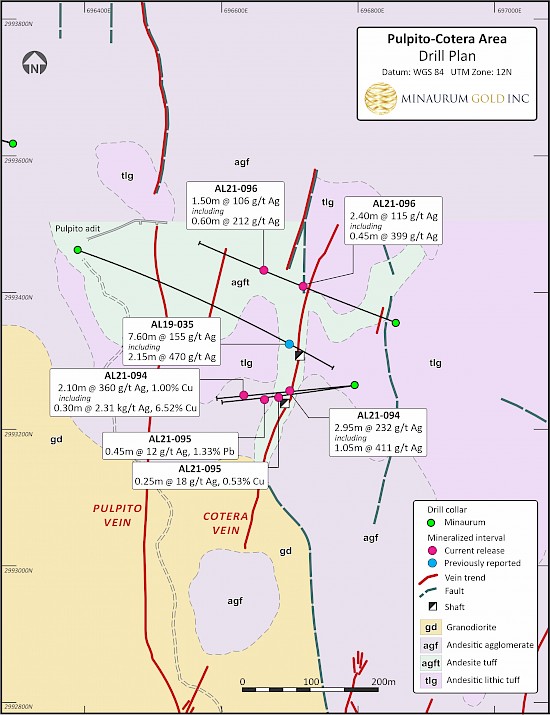
Figure 6. Plan map of the Cotera vein zone, showing geology and drilling. Click on image to enlarge.

Figure 7. Cross section of holes AL21-094 and AL21-095, Cotera zone. Click on image to enlarge.
Alessandra Skarn and Vein Zone
Hole AL21-090 was drilled to cut the up-dip projection of the mineralized zone cut by hole AL21-085 (see News Release dated November 9, 2021) and intersected 13.50 m with an average grade of 0.28% Cu. Drilled approximately 250 m up-dip of the AL21-085, the hole indicates that the grade and width of mineralization increases at depth at the target area.
Holes AL21-093 and AL21-097 were aimed to intersect the mineralized zone about 125 and 250 m north of the AL21-085 intercept, and at approximately the same elevation. These holes returned anomalous mineralization with the zone remaining open at depth and along strike.
Minaurum Gold Inc. (MGG | TSX Venture Exchange; MMRGF | OTCQX; 78M | Frankfurt) is a Mexico-focused explorer concentrating on the high-grade Alamos silver project in southern Sonora. With a property portfolio encompassing multiple additional district-scale projects, Minaurum is managed by one of the strongest technical and finance teams in Mexico. Minaurum's goal is to continue its founders' legacy of creating shareholder value by making district-scale mineral discoveries and executing accretive mining transactions. For more information, please visit our website at www.minaurum.com and follow us on YouTube, Twitter and LinkedIn.
ON BEHALF OF THE BOARD
“Darrell A. Rader”
Darrell A. Rader
President and CEO
For more information, please contact:
Sunny Pannu – Investor Relations and Corporate Development Manager
(778) 330 0994 or via email at pannu@minaurum.com
The TSX Venture Exchange does not accept responsibility for the adequacy or accuracy of this news release.
2710 – 200 Granville Street
Telephone 778 330-0994
Vancouver, BC V6C 1S4
www.minaurum.com
info@minaurum.com
Stephen R. Maynard, Vice President of Exploration of Minaurum and a Qualified Person as defined by National Instrument 43-101, reviewed and verified the assay data, and has approved the disclosure in this News Release. Historical data reported in this news release has not been verified.
Cautionary Note Regarding Forward Looking Statements: Certain disclosures in this release constitute forward-looking information. In making the forward-looking statements in this release, Minaurum has applied certain factors and assumptions that are based on Minaurum’ s current beliefs as well as assumptions made by and information currently available to Minaurum. Although Minaurum considers these assumptions to be reasonable based on information currently available to it, they may prove to be incorrect, and the forward-looking statements in this release are subject to numerous risks, uncertainties and other factors that may cause future results to differ materially from those expressed or implied in such forward-looking statements. Readers are cautioned not to place undue reliance on forward-looking statements. Minaurum does not intend, and expressly disclaims any intention or obligation to, update or revise any forward-looking statements whether as a result of new information, future events or otherwise, except as required by law.
Quality Assurance/Quality Control: Preparation and assaying of drilling samples from Minaurum's Alamos project are done with strict adherence to a Quality Assurance/Quality Control (QA/QC) protocol. Core samples are sawed in half and then bagged in a secure facility near the site, and then shipped by a licensed courier to ALS Minerals' preparation facility in Hermosillo, Sonora, Mexico. ALS prepares the samples, crushing them to 70% less than 2mm, splitting off 250g, and pulverizing the split to more than 85% passing 75 microns. The resulting sample pulps are prepared in Hermosillo, and then shipped to Vancouver for chemical analysis by ALS Minerals. In Vancouver, the pulps are analyzed for gold by fire assay and ICP/AES on a 50-gram charge. In addition, analyses are done for a 48- element suite using 4-acid digestion and ICP analysis. Samples with silver values greater than 100 g/t; and copper, lead, or zinc values greater than 10,000 ppm (1%) are re-analyzed using 4-acid digestion and atomic absorption spectrometry (AAS).
Quality-control (QC) samples are inserted in the sample stream every 20 samples, and thus represent 5% of the total samples. QC samples include standards, blanks, and duplicate samples. Standards are pulps that have been prepared by a third-party laboratory; they have gold, silver, and base-metal values that are established by an extensive analytical process in which several commercial labs (including ALS Minerals) participate. Standards test the calibration of the analytical equipment. Blanks are rock material known from prior sampling to contain less than 0.005 ppm gold; they test the sample preparation procedure for cross-sample contamination. In the case of duplicates, the sample interval is cut in half, and then quartered. The first quarter is the original sample, the second becomes the duplicate. Duplicate samples provide a test of the reproducibility of assays in the same drilled interval. When final assays are received, QC sample results are inspected for deviation from accepted values. To date, QC sample analytical results have fallen in acceptable ranges on the Alamos project.

